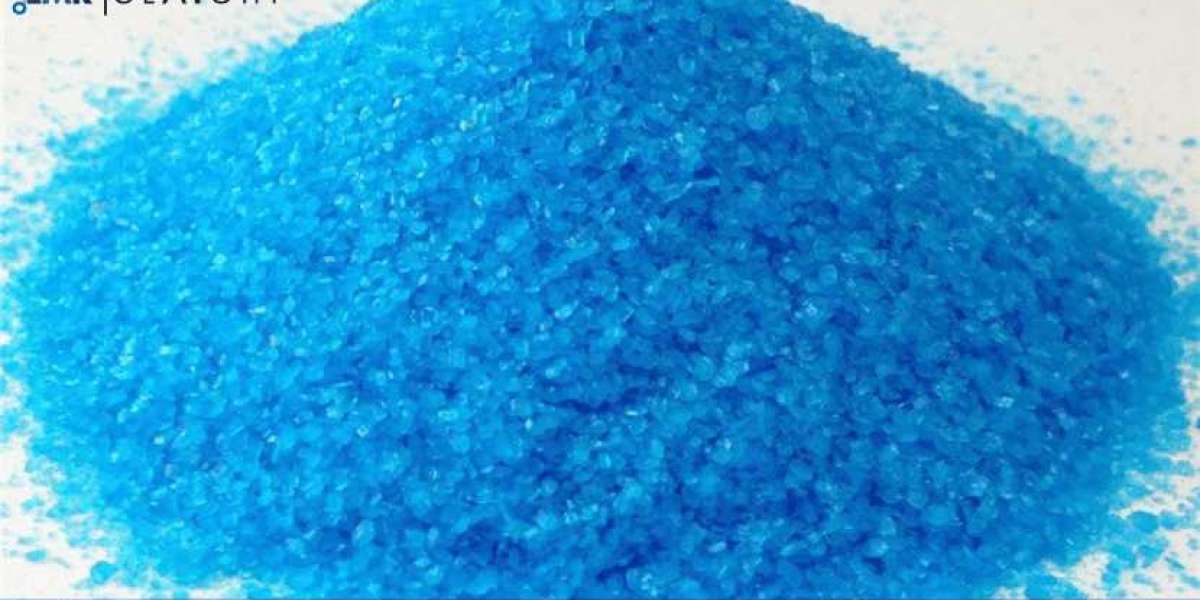Cupric sulfate, commonly known as copper sulfate, is a versatile chemical compound widely used in agriculture, industrial processes, and laboratory applications. Its applications range from serving as a fungicide in crop protection to acting as an essential raw material in electroplating and mining. With its increasing demand across diverse industries, setting up a cupric sulfate manufacturing plant is a promising opportunity. Understanding the production process, raw material sourcing, market dynamics, and regulatory requirements is vital for ensuring the success of such a venture.
Overview of Cupric Sulfate Manufacturing
The manufacturing of cupric sulfate involves the reaction of copper metal or its derivatives with sulfuric acid under controlled conditions. The process requires precision and adherence to quality control standards to produce a high-purity product.
Cupric sulfate is available in different forms, including pentahydrate and anhydrous varieties, catering to specific industrial needs. The demand for this compound continues to rise due to its wide-ranging applications in agriculture, chemicals, and manufacturing sectors.
Get a Free Sample Report with Table of Contents@ https://www.expertmarketresearch.com/prefeasibility-reports/cupric-sulfate-manufacturing-plant-project-report/requestsample
Key Components of the Manufacturing Plant
Establishing a cupric sulfate manufacturing plant requires investment in infrastructure, equipment, and resources:
Location and Infrastructure:
The plant should be strategically located near sources of copper raw materials and transportation hubs for efficient logistics.Raw Material Procurement:
Key raw materials include copper metal, copper oxide, or copper carbonate, and sulfuric acid. Reliable suppliers ensure consistent quality and supply.Machinery and Equipment:
Essential equipment includes reactors, filtration systems, crystallisers, and drying units. Automation enhances precision and efficiency.Workforce and Training:
Skilled personnel are required to operate machinery, maintain safety protocols, and ensure quality control. Regular training improves productivity and compliance with standards.Environmental and Safety Compliance:
Adhering to environmental regulations and implementing waste management systems is critical for sustainable operations.
Production Process
The manufacturing process of cupric sulfate involves several steps to ensure a high-quality product:
Raw Material Preparation:
Copper metal or its derivatives are prepared and cleaned to remove impurities.Reaction with Sulfuric Acid:
The copper source is reacted with sulfuric acid in a controlled environment to produce cupric sulfate.Crystallisation:
The solution is cooled and allowed to crystallise, forming cupric sulfate crystals of the desired size and purity.Filtration and Drying:
The crystals are filtered to remove impurities and dried to achieve the required consistency and moisture content.Packaging and Storage:
The final product is packaged in moisture-resistant containers to preserve its quality during storage and transport.
Quality control measures are implemented at every stage to ensure the product meets industry-specific standards.
Regulatory and Environmental Considerations
Compliance with regulatory standards is essential for the safe and sustainable operation of a cupric sulfate manufacturing plant. Key considerations include:
- Product Standards: Ensuring the final product meets industry specifications for purity and quality.
- Environmental Compliance: Implementing eco-friendly practices, such as recycling waste and minimising emissions, to reduce the environmental impact.
- Worker Safety: Providing safety equipment and adhering to protocols to ensure a secure working environment.
Sustainable practices, including energy-efficient production methods and responsible waste management, enhance the plant’s reputation and align with global sustainability goals.
Cost Analysis
The costs involved in setting up a cupric sulfate manufacturing plant include:
- Raw Materials: Procuring high-quality copper and sulfuric acid forms a significant portion of the budget.
- Machinery and Equipment: Investing in advanced reactors and filtration systems ensures efficient production.
- Labour Costs: Skilled workforce recruitment and training contribute to operational expenses.
- Operational Expenses: Utilities, maintenance, and packaging materials add to the recurring costs.
A detailed cost analysis helps evaluate the financial feasibility of the project and identify opportunities for cost optimisation.
Market Trends and Opportunities
The demand for cupric sulfate is driven by its wide-ranging applications in various industries. Key trends and opportunities include:
Rising Demand in Agriculture:
Cupric sulfate is widely used as a fungicide and fertiliser additive, supporting the growing need for sustainable crop protection solutions.Expansion in Industrial Applications:
The compound’s use in electroplating, mining, and chemical synthesis drives demand in industrial sectors.Increased Use in Water Treatment:
Cupric sulfate is employed as an algaecide in water treatment processes, aligning with the growing focus on clean water resources.Export Potential:
Emerging markets with expanding agricultural and industrial bases present significant export opportunities for manufacturers.Technological Advancements:
Innovations in production processes and sustainable practices create opportunities to improve efficiency and reduce costs.
Challenges in Manufacturing
While cupric sulfate manufacturing presents lucrative opportunities, it also involves challenges such as:
- Raw Material Costs: Fluctuations in copper prices can impact production costs.
- Regulatory Compliance: Meeting stringent environmental and safety regulations requires careful planning and investment.
- Market Competition: Differentiating products and optimising costs are essential to staying competitive.
- Environmental Concerns: Sustainable waste management and eco-friendly production methods are necessary to meet consumer and regulatory expectations.
Final Thoughts
Establishing a cupric sulfate manufacturing plant requires a comprehensive understanding of production processes, market dynamics, and regulatory requirements. By addressing challenges and leveraging growth opportunities, manufacturers can create a sustainable and profitable business in this essential industry.








